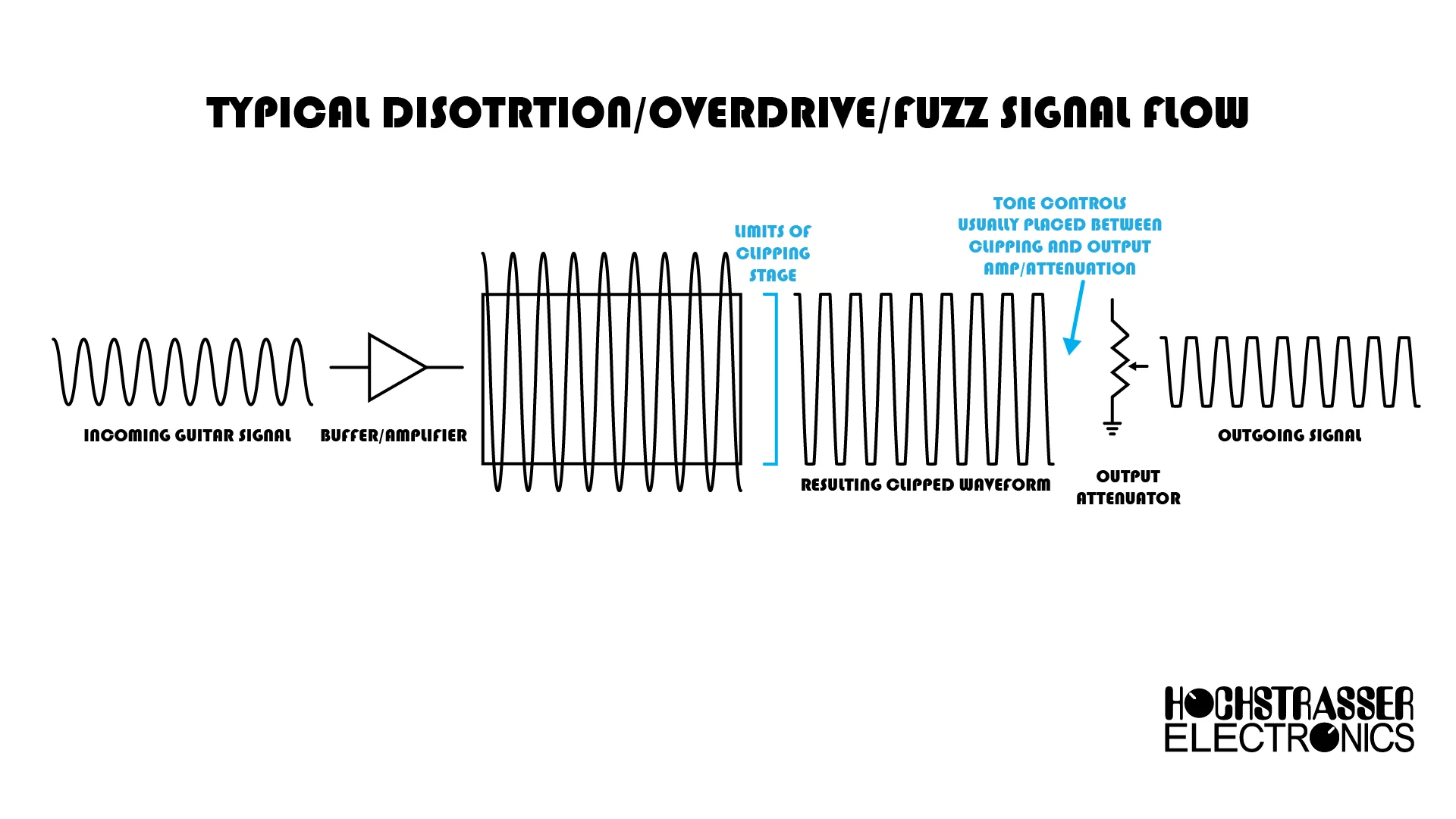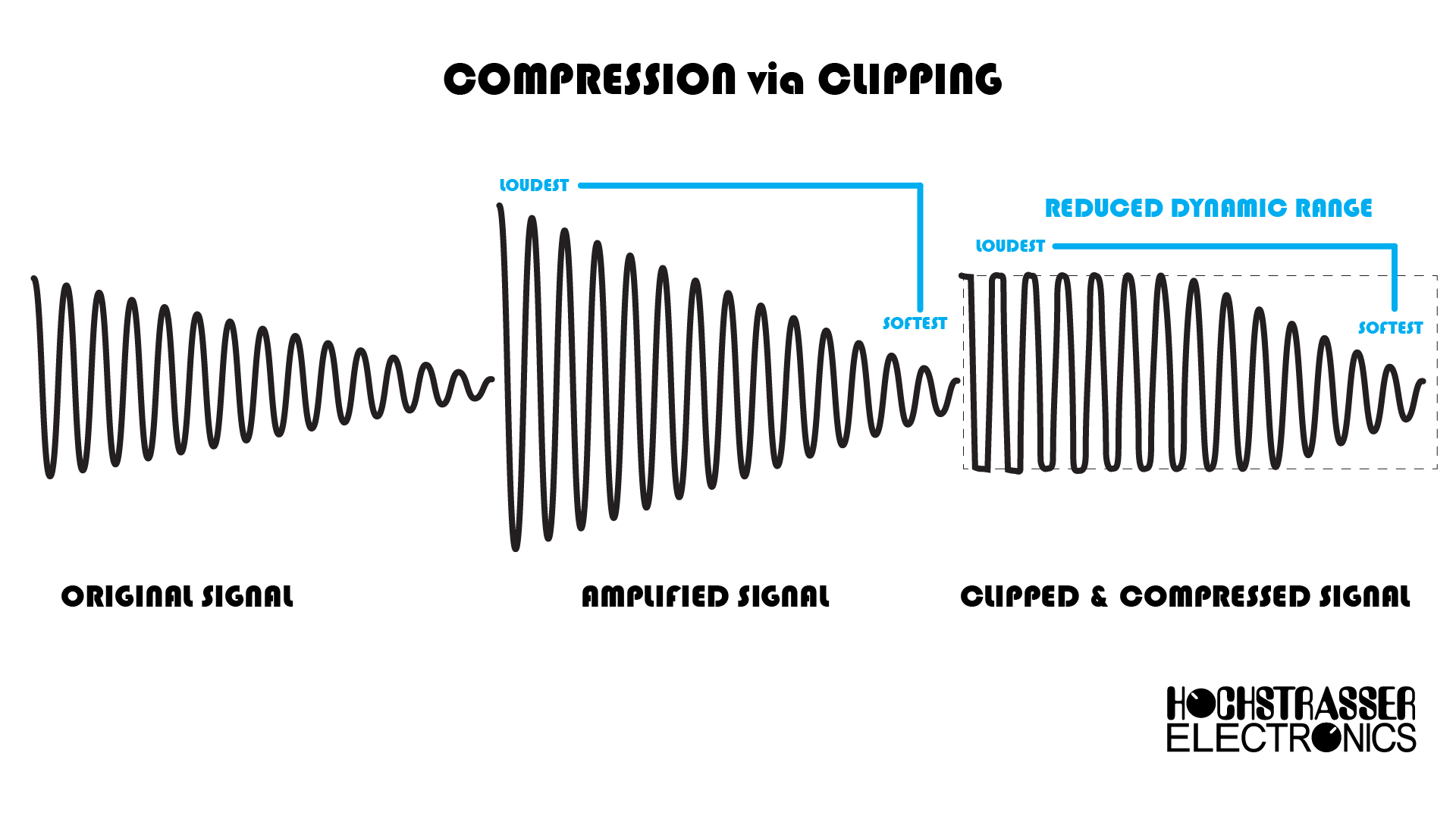Stacking Distortions
Stacking Distortions: Tonal Shaping Through Gain Staging
Distortion, fuzz, and overdrive are the most commonly used effects with the electric guitar. Whether turning one’s lead tone into a square, cello-like sound or offering some grind to massive power chords, every genre of music since the advent of the electric guitar has explored distortion in one way or another.
Distortion can be achieved by driving an amp extra hard or deploying aggressive effects chains. Stacked distortion, overdrive, or fuzz is a concept that you might encounter while shopping for guitar pedals or exploring anything related to the electric guitar on social media. While the concept of reordering your pedals to change the tone quality is nothing new, it can have exceptional consequences when it comes to those effects that deliver crunch, buzz, raunch, filth, and whoompf.
Basic Gain Staging
Consider using a marker to draw squiggly lines on pieces of paper of various sizes. On larger sheets of paper your lines may never get close to the edge; on smaller pieces of paper you need to draw smaller squiggles to get them to fit. If you don’t change the size of the squiggles, or if they should get even larger, they simply run off the page.
Audio gain stages are like these pieces of paper, each with a potentially different maximum allowable signal size. The individual pieces of the chain have respective operating limits as the signal passes through; the signal can either change in size to adapt to each piece of the chain or it can experience clipping— when the squiggles run off the page — the extra information lost to the abyss and replaced with a flat line.
This limit is commonly referred to as headroom. Circuits that allow for more signal to pass through before clipping are said to have higher headroom and circuits that clip smaller signals are said to have lower headroom.
In pro audio and live sound, one of the engineer’s main goals is to minimize the chance of clipping wherever possible, unless distortion is needed for creative effect. Close attention is paid at each gain stage to ensure that the full signal gets through by being either attenuated or amplified appropriately and passed onto the next stage without any unintended loss of information due to clipping.
Clipping
The sound of a waveform changes as its shape changes. By truncating the upper and lower excursions of a waveform (as occurs with clipping) and replacing those sections with a flat line, the resulting shape changes significantly from the one that was input. In particular, as waves get more square they experience an increase in harmonics that are odd-number multiples of the fundamental frequency. If your note is oscillating at 100Hz, you would see increased levels of harmonics at 300Hz, 500Hz, 700Hz, etc.
Cutting off the tops of the waveforms can be done in a multitude of ways, some methods leaving sharp edges and others yielding rounded corners. Clipping can also occur at different frequencies. The nature of all this reshaping results in different harmonics being produced or accentuated in the sound we hear.
While the guitar is naturally a rich and beautiful sounding instrument on its own, the opportunity to create and manipulate harmonic information is a wondrous field of research. It can shape the personality of the instrument in ways that allow us to differentiate between a squeaky clean bebop tone, heavily distorted progressive metal, or slightly crunchy indie rock tones. Electric guitars and distortion go hand-in-hand.
We will leave the differences between fuzz, overdrive, boost, distortion, and amp-in-a-box effects for another time and for now will accept that they all cause some sort of clipping. Any given distortion device creates one or several opportunities under the hood for a signal to be amplified and then fed into a clipping stage. Clipping stages typically deploy diodes, transistors, or tubes to create a situation wherein the waveform gets cut off or reshaped.
In all scenarios, distortion involves some amount of making a signal louder and feeding it into a circuit that will clip when handed such a large signal. Because this process is largely based on cranking up the signal, most distortion pedals have an output attenuator at the end of the chain, usually labeled as Volume or Level. This allows the user to create more distortion earlier in the circuit, without having an uncontrollably loud signal at the output.
Some circuits clip more within a certain range of frequencies, thus shifting the character even further. All of these differences lead to significant tonal changes, causing guitar players to yearn for large collections of diverse crunch and fuzz pedals. As we mix these different effect varieties together, our options and resulting tones continue to expand.
Stacked distortion, overdrive, fuzz, and boosts
Pedalboards are typically “stacked”, but that term doesn’t generally get used to describe most effect combinations. In the case of something like a phaser and delay, putting the phaser first does not cause the delay to change its character. They function somewhat independently, each blindly doing their thing to the sound being passed forward by the previous effect. This is not to say that changing the order of effects won’t make a difference, but simply that the characteristics of the phaser will not cause changes in delay time, feedback, or other parameters within the delay.
Stacking distortions (or overdrives or fuzzes or slightly dirty boosts) is the process of using multiple distortion circuits to create a compounded clipping effect. The term “stack” is synonymous with “cascade” or “serially connected.” Because distortion devices generate and accentuate overtones in an aggressive way, their effect is more cumulative when using multiple devices of the same species.
The simplest iteration of stacked distortions is found when running a boost pedal into a cranked tube amp. The amp is technically not a pedal, but it is a device that can induce overdrive if pushed hard enough. The amp will have one sound on its own and then the added gain from the boost pedal will cause its character to change, leading to a more distorted tone.
The beauty of using a relatively clean amp and achieving distortion effects with pedals is that it can allow more control over certain parameters, while offering an opportunity to bypass different parts of the chain with a footswitch, instead of being locked into a single cranked amp.
Tonal Flexibility and Control
Stacking creates a tiered approach wherein components can be brought in and out for more precise control and greater diversity of sounds. Tonal flexibility is the true magic of stacked distortions.
Let’s say we’re using two overdrive pedals. The first is set to be a slightly dirty boost. The second will be set to be dirtier. Each effect on its own will perform one task, but when the slightly dirty boost feeds into the dirtier overdrive, it causes that second overdrive to become more saturated, generating a whole new flavor of distortion. We have the opportunity to explore 3 different sounds using 2 different pedals. We also will usually have the ability to tweak the tone/EQ in most overdrives and the culmination of those controls gives even more sonic possibilities.
If we had a fuzz set with the fuzz control fairly low and then ran an overdrive into it, this would push the effect into heavy fuzz territory. Why would we do this? Instead of kneeling down to mess with the settings while jamming, we can preset multiple flavors beforehand and footswitch between them. Additionally, the tone controls on the overdrive will give us shaping opportunities beyond those found by simply turning up the fuzz control. Even further beyond that, the gently clipped sound of the overdrive will behave differently as it moves through the fuzz circuit than the dry, unclipped guitar sound would.
Compression and Clipping
Because clipping effectively caps the maximum size of the waveform, there is a certain amount of compression that occurs during the process. Compression attenuates loudest parts of a sound, then amplifies everything, making the quietest parts almost as loud as the loudest parts. It’s important to pay attention to the output levels of each device to manage this phenomenon. While compression happens in a single distortion effect, it becomes even more apparent as these effects are chained together.
One of the “dangers” in stacking distortions is reaching this point of maximum saturation. Since clipping pushes the guitar signal towards a square shape, eventually there can be a point where you’re attempting to make a square wave more square. This can increase compression and make things sludgy, but it may not offer any tonal rewards. It also might sound awesome so don’t be afraid to explore.
Know Your Tone
There are no wrong answers in guitar pedals (other than plugging them in backwards or using an incorrect power source) so if you find a sound you like, enjoy it! However, if you’re feeling frustrated while playing around with multiple distortions, remember that you could be oversaturating the signal of the latter pedals and may want to pull down the Level/Volume/Output control on the earlier pedals in the chain. There will, of course, always be some balancing and tweaking to follow, but that’s part of the fun.
One of the other joys in stacking distortions is found in the modularity of mixing and matching different distortion types. Two overdrives will sound different than an overdrive paired with a fuzz or a hard clipping distortion plugged into an octave fuzz. There are no rules about how to order such things, although there are countless internet threads asking for such recommendations. I personally prefer putting overdrives before fuzzes, but your tastes may lead you elsewhere.
Multiple Pedals and Multi-Pedals
Using separate pedals is a great way to experiment with stacking distortions. You can try them in different orders, put other pedals in between, and fine-tune to taste.
There are many pedals being made that feature multiple distortions, overdrives, fuzzes, or boosts inside of one box. The Keeley D&M Drive, the AnalogMan King of Tone, the Coppersound Foxcatcher, and of course our Helping Friendly Box and Waffle Cone pedals all pack multiple devices for sonic manipulation under one hood.
Why go with a single box solution? Often times the circuits that are housed together are tweaked to play well with one another. It also saves on pedalboard space and power supply taps to run one pedal that functions as two. Combined pedals also help cut back on patch cable runs which can help to reduce noise and tone loss.
The most important rule in stacking distortions is to use you ears. What may be oversaturated for one player may be too mild for another. The nature of a given stack may change as you swap out guitars, amps, and other pedals. While we have primarily looked at using two devices together, remember that with enough patch cables, power supplies, and imagination, there’s no limit to your pedalboard possibilities.


